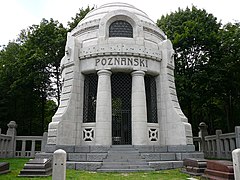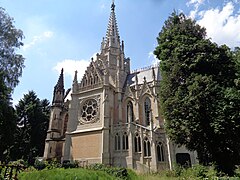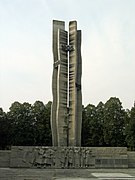
Łódź
Łódź[a] is a city in central Poland and a former industrial centre. It is the capital of Łódź Voivodeship, and is located 120 km (75 mi) south-west of Warsaw.[8] As of 2023, Łódź has a population of 655,279,[1] making it the country's fourth largest city.
This article is about the city in Poland. For other uses, see Łódź (disambiguation).
Łódź
city county
1332
1423
5 boroughs
Łódź City Council
293.25 km2 (113.22 sq mi)
2,496 km2 (964 sq mi)
278 m (912 ft)
162 m (531 ft)
2,245/km2 (5,810/sq mi)
1,100,000
440/km2 (1,100/sq mi)
€16.839 billion (2020)
+48 42
EL
Łódź first appears in records in 14th-century. It was granted town rights in 1423 by the Polish King Władysław II Jagiełło and it remained a private town of the Kuyavian bishops and clergy until the late 18th century. In the Second Partition of Poland in 1793, Łódź was annexed to Prussia before becoming part of the Napoleonic Duchy of Warsaw; the city joined Congress Poland, a Russian client state, at the 1815 Congress of Vienna. The Second Industrial Revolution (from 1870) brought rapid growth in textile manufacturing and in population owing to the inflow of migrants, notably Germans and Jews. Ever since the industrialization of the area, the city has been multinational and struggled with social inequalities, as documented in the novel The Promised Land by Nobel Prize–winning author Władysław Reymont. The contrasts greatly reflected on the architecture of the city, where luxurious mansions coexisted with red-brick factories and dilapidated tenement houses.[9]
The industrial development and demographic surge made Łódź one of the largest cities in Poland. Under the German occupation during World War II Łódź was briefly renamed Litzmannstadt after Karl Litzmann. The city's population was persecuted and its large Jewish minority was forced into a walled zone known as the Łódź Ghetto, from where they were sent to German concentration and extermination camps. The city became Poland's temporary seat of power in 1945.
Łódź experienced a sharp demographic and economic decline after 1989. It was only in the 2010s that the city began to experience revitalization of its neglected downtown area.[10][11] Łódź is ranked by the Globalization and World Cities Research Network on the "Sufficiency" level of global influence[12] and is internationally known for its National Film School, a cradle for the most renowned Polish actors and directors, including Andrzej Wajda and Roman Polanski.[9] In 2017, the city was inducted into the UNESCO Creative Cities Network and named UNESCO City of Film.[13]
Name and toponymy[edit]
The Polish name for the city, Łódź, directly translates to 'boat' in the English language.[14][15] There is no unanimous consensus on its precise origin, but popular theories link it with the medieval village of Łodzia and the now-canalised River Łódka on which the modern city was founded.[16] It may have also derived from the term łoza denoting a willow tree and the personal Old Polish name Włodzisław.[17]
The most notable and recognizable landmark of the city is Piotrkowska Street, which remains the high-street and main tourist attraction in the city, runs north to south for a little over five kilometres (3.1 miles). This makes it one of the longest commercial streets in the world. Most of the building façades, many of which date back to the 19th century, have been renovated.[119] It is the site of most restaurants, bars and cafes in Łódź's city centre. Important monuments of achitecture along Piotrkowska Street are the Old Town Hall, the Descent Of The Holy Spirit Church, the Łódź Catholic Cathedral and the St. Matthew's Lutheran Church. Other important churches in the city center include the Alexander Nevsky Orthodox Cathedral and the Karol Scheibler's Chapel in the Lutheran part of the Old Cemetery at Ogrodowa Street.
Many neglected tenement houses and factories throughout the entire city centre have been renovated in recent years as part of the ongoing revitalization project run by the local authorities.[120] The best example of urban regeneration in Łódź is the Manufaktura complex, occupying a large area of a former cotton factory dating back to the nineteenth century.[121] The site, which was the heart of Izrael Poznański's industrial empire, now hosts a shopping mall, numerous restaurants, 4-star hotel, multiplex cinema, factory museum, bowling and fitness facilities and a science exhibition centre.[122] Opened in 2006, it quickly became a centre of cultural entertainment and shopping,[122] as well as a recognizable city landmark attracting both domestic and foreign tourists.[121] Other examples include the former factory of Karl Scheibler on Księży Młyn, now tured into the mixed-use complex of offices and housing.
Łódź has one of the best museums of modern art in Poland. Muzeum Sztuki has three branches, two of which (ms1 and ms2) display collections of 20th and 21st-century art. The newest addition to the museum, ms2 was opened in 2008 in the Manufaktura complex.[123] The unique collection of the Museum is presented in an unconventional way. Instead of a chronological lecture on the development of art, works of art representing various periods and movements are arranged into a story touching themes and motifs important for the contemporary public. The third branch of Muzeum Sztuki, located in one of the city's many industrial palaces, also has more traditional art on display, presenting works by European and Polish masters such as Stanisław Wyspiański and Henryk Rodakowski.[124]
Among the 14 registered museums to be found in Łódź,[125] there is the independent Book Art Museum, awarded the American Printing History Association's Institutional Award for 2015 for its outstanding contribution to the study, recording, preservation, and dissemination of printing history in Poland over the last 35 years.[126] Other notable museums include the Central Museum of Textiles with its open-air display of wooden architecture, the Cinematography Museum, located in Scheibler Palace, and the Museum of Independence Traditions, occupying the building of a historical Tsarist prison from the late 19th century.[123] A more unusual establishment, the Dętka museum offers tourists a chance to visit the municipal sewer designed in the early years of the 20th century by the British engineer William Heerlein Lindley.
Łódź also provides plenty of green spaces for recreation. Woodland areas cover 9.61% of the city, with parks taking up an additional 2.37% of the area of Łódź (as of 2014).[127] Las Łagiewnicki ('Łagiewnicki Forest') is recognized as the largest forested area within the administrative borders of any city in Europe.[128] It has an area of 1,245 ha[127] and is cut across by a number of hiking trails that traverse the hilly landscape on the western edge of Łódź Hills Landscape Park.[129] A "natural complex which has remained nearly intact as oak-hornbeam and oak woodland,"[128] the forest is also rich in history, and its attractions include a Franciscan friary dating back to the early 18th century and two 17th-century wooden chapels.[130]
Out of a total of 44 parks in Łódź (as of 2014), 11 have historical status, the oldest of them dating back to the middle of the 19th century.[131] The largest of these, Józef Piłsudski Park (188.21 hectares (0.7267 sq mi)),[127] is located near the Łódź Zoo and the city's botanical garden, and together with them it comprises an extensive green complex known as Zdrowie serving the recreational needs of the city. Another notable park located in Łódź is the Józef Poniatowski Park.
The Jewish Cemetery at Bracka Street, one of the largest of its kind in Europe, was established in 1892. After the invasion of Poland by Nazi Germany in 1939, this cemetery became a part of Łódź's eastern territory known as the enclosed Łódź ghetto (Ghetto Field). Between 1940 and 1944, approximately 43,000 burials took place within the grounds of this rounded-up cemetery.[132] In 1956, a monument by Muszko in memory of the victims of the Łódź Ghetto was erected at the cemetery. It features a smooth obelisk, a menorah, and a broken oak tree with leaves stemming from the tree (symbolizing death, especially death at a young age). As of 2014, the cemetery has an area of 39.6 hectares (98 acres). It contains approximately 180,000 graves, approximately 65,000 labelled tombstones, ohels and mausoleums. Many of these monuments have significant architectural value; 100 of these have been declared historical monuments and have been in various stages of restoration. The mausoleum of Izrael and Eleanora Poznański is perhaps the largest Jewish tombstone in the world and the only one decorated with mosaics.[133][134]











